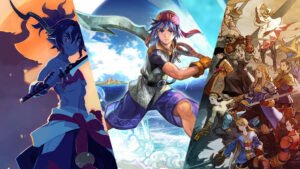In the world of game development, two primary creative roles take center stage: game artists and game designers. While both contribute to the overall game creation process, it’s important to understand the distinctions between game art and game design to determine which path suits you best. Let’s delve with https://room8studio.com/ into the differences between game art and game design and explore each role’s unique responsibilities and contributions.
Understanding Game Art
Game art revolves around delivering the visual aspects that define a game’s look and feel. As a game artist, you play a supportive role in the development process, bringing the game’s aesthetics to life. To illustrate this distinction, we can draw a parallel with a traditional board game like chess.

In this analogy, the game artist would be responsible for designing the board and chess pieces, ensuring they are visually appealing and practical—such as differentiating between player pieces and opponent pieces. On the other hand, the game designer determines how these pieces move on the checkerboard and how they interact and compete with each other.
The Role of a Game Artist
A game artist’s primary focus is to visually convey the story and atmosphere of the game. Starting from initial sketches and prototypes, known as assets, game artists bring characters, objects, and environments to life. These assets serve as the building blocks that comprise the game world. To achieve their final form, characters undergo 3D modelling, adding depth, movement, and lifelike qualities as they navigate the game world.

In addition to character modelling, game artists are responsible for creating a library of 3D assets used to populate various game levels. They curate and catalogue these resources throughout production and even the support phase. Storyboarding is another crucial aspect of their role, as they visually map out the game’s progression and illustrate its functioning elements. Game artists maintain continuity and ensure consistent and believable visuals within the game’s realm.
Specializations in Game Art
Within the field of game art, there are numerous areas of specialization to explore. These include character artist, environmental artist, concept artist, particle effects artist, art director, and digital illustrator. In practice, there may be a crossover between these roles, and you may find yourself performing a combination of functions throughout your career.
The Vital Role of Game Design
Game design takes center stage as the driving force behind video game production’s creative and project management aspects. With substantial creative and managerial influence, game designers serve as the main players in game creation. Depending on the team size, they may be responsible for crafting the game’s narrative structure and plotting its gameplay mechanics.

The Responsibilities of a Game Designer
Game designers collaborate closely with all key departments involved in game development, including programmers, artists, quality assurance, marketing, and distribution. They assume a role akin to that of a producer, overseeing scheduling, budgeting, and all elements of the production process. Their goal is to successfully drive the game to completion, requiring a unique combination of creative, technical, and project management skills.
On the creative side, game designers contribute to the game’s storyline, guide the visual style, and design scenarios and levels. They work closely with game artists to ensure the realization of the game’s vision, keeping artist teams aligned with the right brief, on schedule, and within budget. Collaboration with programmers is also vital, ensuring creative and technical teams work in sync to maintain production progress.

Evolving Roles in Game Design
As games become more complex and development teams grow larger, specific roles within game design may be further specialized. Level designers focus on creating and implementing levels, environments, stories, and quests, while systems designers concentrate on designing and implementing minute-to-minute gameplay systems such as controls, movement, and combat.
Choosing the Right Path: Game Artist or Game Designer?
When considering a career in the realm of video game art or game design, it’s essential to evaluate your strengths and interests. If you possess artistic talent, enjoy the visual medium, and are fascinated by game development’s microelements, pursuing a video game artist career may be the ideal fit. On the other hand, if you have a broad range of creative and technical skills and find yourself drawn to the macro view of game design, becoming a game designer might be your chosen path.

Now that you understand the distinctions between video game art and video game design let’s explore the fascinating process of game development. The creation of a video game involves various stages, each crucial to bringing the game to life.
- Conceptualization: This initial phase involves brainstorming ideas, defining the game’s concept, and outlining its core mechanics. Game designers play a pivotal role in shaping the game’s vision during this stage.
- Pre-production: In this phase, the team further refines the game concept and creates detailed design documents. Game artists begin visualizing the game world, characters, and environments based on the designer’s brief. This collaboration between artists and designers ensures a cohesive vision for the game.
- Production: The production phase is where the game starts to take shape. Game artists create the assets, models, animations, textures, and visual effects that populate the game world. Their work breathes life into the characters and environments, immersing players in captivating visuals.
- Level Design: Working closely with game designers, level designers are responsible for crafting the game’s levels, puzzles, and challenges. They ensure a seamless and engaging player experience, balancing gameplay mechanics and visual aesthetics.
- Programming: Programmers bring the game to life by writing the code that drives its functionality. They work closely with game designers to implement the mechanics and features envisioned during the design phase.
- Quality Assurance: Game testers play a vital role in the development process. They meticulously test the game, identifying and reporting bugs, glitches, and other issues. This feedback loop helps refine the game and ensure a smooth and enjoyable experience for players.
- Iteration and Polish: As the game nears completion, the team focuses on polishing the gameplay, refining visuals, and addressing any remaining issues. Game artists and designers work collaboratively to fine-tune every aspect, striving for perfection.
- Release and Post-Production: Once the game is ready, it is released to the market. The work of game artists and designers doesn’t end here, though. They continue to support the game post-release, creating additional content, updates, and expansions to enhance the player experience.
Game development is a collaborative effort that relies on the expertise and contributions of video game artists and designers. Their collaboration is essential in creating captivating visuals, engaging gameplay mechanics, and immersive experiences for players.
In conclusion, video game art and game design are distinct yet interconnected roles within the game development process. Game artists bring the visual elements to life, while game designers drive the creative and project management aspects.
By understanding the differences between these roles, you can determine the path that aligns with your skills and passions. So, whether you aspire to be a game artist or a game designer, embrace the exciting journey of game development and unlock your potential in the world of video game art.



